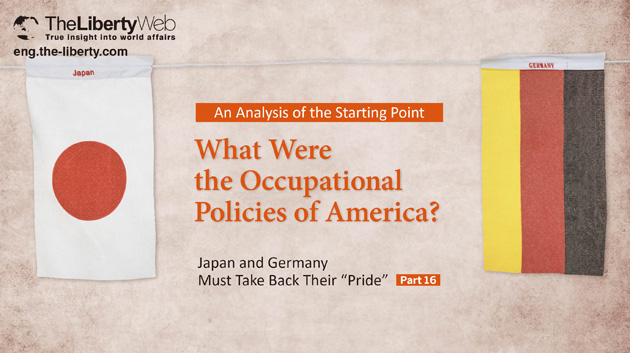What Were the Occupational Policies of America?
An Analysis of the Starting Point:
We learned in school that “Japan abandoned militarism and became democratic due to the American occupation.” What were this occupational policies that changed America from an enemy nation to a “righteous” nation “bringing democracy”?
What Did the GHQ Do?
During the 7 years of the occupational policies in Japan, the GHQ tried to completely destroy the roots of the nation: religion, military, and the economy. It was the plan known as the “War Guilt Information Program,” which tried to instill war guilt in the Japanese at its core.
1. Make Japanese Think that “Japan Is an Evil Nation”
The GHQ thoroughly rooted in the consciousness of the Japanese that “Japan is an evil nation”. That is the “Great Pacific War historical perspective,” which states that Japan before the war was a militaristic and aggressive nation. It was no longer possible to teach children Japan’s historical achievements such as that the Japanese were the first people of color to succeed in modernization, and the liberation of Asia from Western colonialism that was based on racial discrimination.
2. Established Constitution for Occupation
Based on the idea that Japan was an “aggressive nation,” the Japanese Constitution was created from a draft that the GHQ developed in a period of 10 days. Article 9, which forbids the retention and engagement of a military, was included for the purpose of the Occupation. It was similar to the former Constitution that the Philippines, an American colony, had in effect for that same purpose.
3. Denial of National Shintoism
The GHQ thought that “Shinto” must have been the source of Japan’s strength as Japan fought a modern war as a country without resources, and by the “Shinto Directive,” banned national Shintoism. Additionally, the Constitution limited the role of the royal family (Article 14), and currently the emperor system is facing danger of extinction. The separation of church and state (Article 20) is also part of this.
4. Education that Does Not Teach Patriotism
The GHQ banned acts of allegiance to the nation, that is, the hoisting of the Hinomaru and singing the national anthem. Furthermore, with the “faculty expulsion decree,” they ousted 120,000 educators who taught patriotism. After that, the anti-Japanese teachers took their place. More so, they abolished the “Imperial Rescript on Education” that taught things like “take care of your parents,” and “apply yourself to studying.” It became impossible to teach patriotism and ethics.
5. Public Office Expulsion and Censorship
The “Public Office Expulsion Decree” was established nominally to eliminate war collaborators, and abolished over 200,000 jobs. Tanzan Ishibashi, who would later become prime minister, and Kounosuke Matsushita, were also expelled. Due to this, communists entered various offices, and the education and the media all became left wing. Further, the GHQ carried out strict censorship and prohibited affirmations of prewar and wartime Japan, and criticism of the Allies.
6. Socialization Through Such Things as the Dissolution of the Zaibatsu
The GHQ, believing that the economic foundation built by the zaibatsu must have supported the strength of Japan, carried out the “dissolution of the zaibatsu”. They further ordered to make land reforms and create Unions. In the name of democratization, they attacked the wealthy, and carried out socialistic policies that would bring workers together.
↓
As a Result, Japan Lost Its Patriotism and Military Power, and Became Weak
According to the political scientist, Burke, who developed an understanding from his research on the French Revolution that what is of great importance for nation building is “religion and ethics rooted in tradition”. As the GHQ abolished Japan’s traditional “Shintoism”, Japan has been weakened from the inside.
Also, according to the philosopher Montesquieu, who deeply studied Rome, patriotism and military power is necessary for creating democracy. Here, too, the GHQ instilled the consciousness that “Japan is an evil nation” and diminished patriotism. Moreover, imagining that “military=aggression”, aversion to the military has become endemic, and is fostering a dangerous national defense situation today.
The point is that the Occupational policies of the GHQ were targeted at “preventing Japan from ever going up against the United States again.” In the sense that they aimed to eradicate one ethnic group, we can say that the Occupational policies were a “spiritual holocaust”.
At the Root of the Occupational Policies Is the “Holy War Ideology” of America’s that Reversed Tradition
That such punitive Occupational policies were carried out was because the States had this idea that reversed historical ideology.
The West has a tradition of “refraining from interfering with the enemy nation’s religion and ethics”. This came about as a result of the 17th century’s ghastly Thirty Years War that occurred within the Holy Roman Empire. After this, and for about 250 years, when the Treaty at Westphalia was signed in 1648, up until the First World War, war was like a duel between soldiers.
However, America inaugurated a crusading holy war ideology, apparently thinking, “We alone are in the right”, and returned to the practices of the Dark Ages, reversing civilized post-war tradition, wherein it was acceptable to “carry out punitive occupations and commit wars of annihilation if the enemy is evil.” The dropping of the atomic bomb and the punitive occupational policies are based on this ideology.
Related
- "Germans Are Unable to Express Their Patriotism":An Interview with Professor Ernst Nolte
- Germans Lost Diligence After the War : An Interview with Emi Kawaguchi-Mahn : Japan and Germany Must Take Back Their Pride (Part 12)
- Was President Roosevelt Truly a "Hero"? - Japan and Germany Must Take Back Their "Pride" (Part 13)
- Roosevelt Deceived the American Citizens and Congress : Japan and Germany Must Take Back Their "Pride" (Part 14)
- GHQ Completely Occupied the Japanese Spirit : Japan and Germany Must Take Back Their "Pride" (Part 15)



















